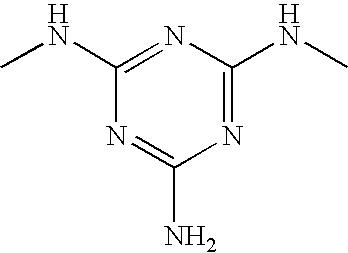Method for making colored silicone hydrogel contact lenses
a silicone hydrogel and contact lens technology, applied in the dyeing process, instruments, spectales/goggles, etc., can solve the problems of corneal swelling, unfavorable corneal blood vessel growth, and oxygen cannot easily circumvent the lens, so as to increase the lathability
- Summary
- Abstract
- Description
- Claims
- Application Information
AI Technical Summary
Benefits of technology
Problems solved by technology
Method used
Image
Examples
example 1
[0132]This example describes synthesis of a precursor to a photo-curable binder polymer and synthesis of a photo-curable binder polymer.
Synthesis of a Silicone-Containing Polymer Having Pendant Functional Groups
[0133]A 1 liter jacketed glass reaction kettle is charged with a solution consisting of VAZO-64 (0.6472 grams), DMA (106.09 g), TRIS (106.26 g), mercaptoethanol (0.253 g), HEMA (37.55 g) and ethylacetate (301.9 g). Nitrogen is bubbled through the mixture for about 15 minutes at room temperature and then the mixture is heated to 40° C. and stirred at about 200 RPM. After about 16 hours, the reaction mixture becomes noticably more viscous. The reaction is monitored by FT-IR analysis. After a total reaction time of about 20 hours, a solution consisting of 11 mg 4-hydroxy-TEMPO (4-Hydroxy-2,2,6,6-Tetramethylpiperidinyloxy, free radical) and 2.38 grams of ethylacetate is added to the reaction mixture. Gravimetric analysis of the reaction mixture indicates that the solution has a s...
example 2
Synthesis of Silicone-containing Macromer
[0136]51.5 g (50 mmol) of the perfluoropolyether Fomblin® ZDOL (from Ausimont S.p.A, Milan) having a mean molecular weight of 1030 g / mol and containing 1.96 meq / g of hydroxyl groups according to end-group titration is introduced into a three-neck flask together with 50 mg of dibutyltin dilaurate. The flask contents are evacuated to about 20 mbar with stirring and subsequently decompressed with argon. This operation is repeated twice. 22.2 g (0.1 mol) of freshly distilled isophorone diisocyanate kept under argon are subsequently added in a counterstream of argon. The temperature in the flask is kept below 30° C. by cooling with a waterbath. After stirring overnight at room temperature, the reaction is complete. Isocyanate titration gives an NCO content of 1.40 meq / g (theory: 1.35 meq / g).
[0137]202 g of the α,ω-hydroxypropyl-terminated polydimethylsiloxane KF-6001 from Shin-Etsu having a mean molecular weight of 2000 g / mol (1.00 meq / g of hydroxy...
example 3
[0140]DMA, macromer prepared in Example 2, TRIS, t-butyl styrene, and VAZO-52 are mixed to prepare a solvent free formulation shown in Table 1 for making room temperature lathable silicone hydrogel materials. t-butyl styrene is added in a formulation to ensure miscibility of all components in the absence of solvent (e.g., ethanol) and to enhance lathing characteristics (increaed Tg) of the polymer.
[0141]
TABLE 1ComponentsFormulation (% by weight)DMA33.72Macromer*37.91TRIS18.12t-butylstyrene9.99VAZO-520.253*Prepared in Example 2.
PUM
| Property | Measurement | Unit |
|---|---|---|
| Tg | aaaaa | aaaaa |
| molecular weights | aaaaa | aaaaa |
| temperature | aaaaa | aaaaa |
Abstract
Description
Claims
Application Information
 Login to View More
Login to View More - R&D
- Intellectual Property
- Life Sciences
- Materials
- Tech Scout
- Unparalleled Data Quality
- Higher Quality Content
- 60% Fewer Hallucinations
Browse by: Latest US Patents, China's latest patents, Technical Efficacy Thesaurus, Application Domain, Technology Topic, Popular Technical Reports.
© 2025 PatSnap. All rights reserved.Legal|Privacy policy|Modern Slavery Act Transparency Statement|Sitemap|About US| Contact US: help@patsnap.com

